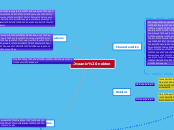af Darianne Cabral 6 år siden
307
Oceanic nekton
Nekton, predominantly vertebrates, are powerful swimmers inhabiting the upper layers of the open ocean, known as the epipelagic zone. These creatures, which include various species of sharks, fish, marine mammals, and cephalopod mollusks, exhibit significant adaptations that enhance their mobility, sensory perception, and ability to evade predators.









